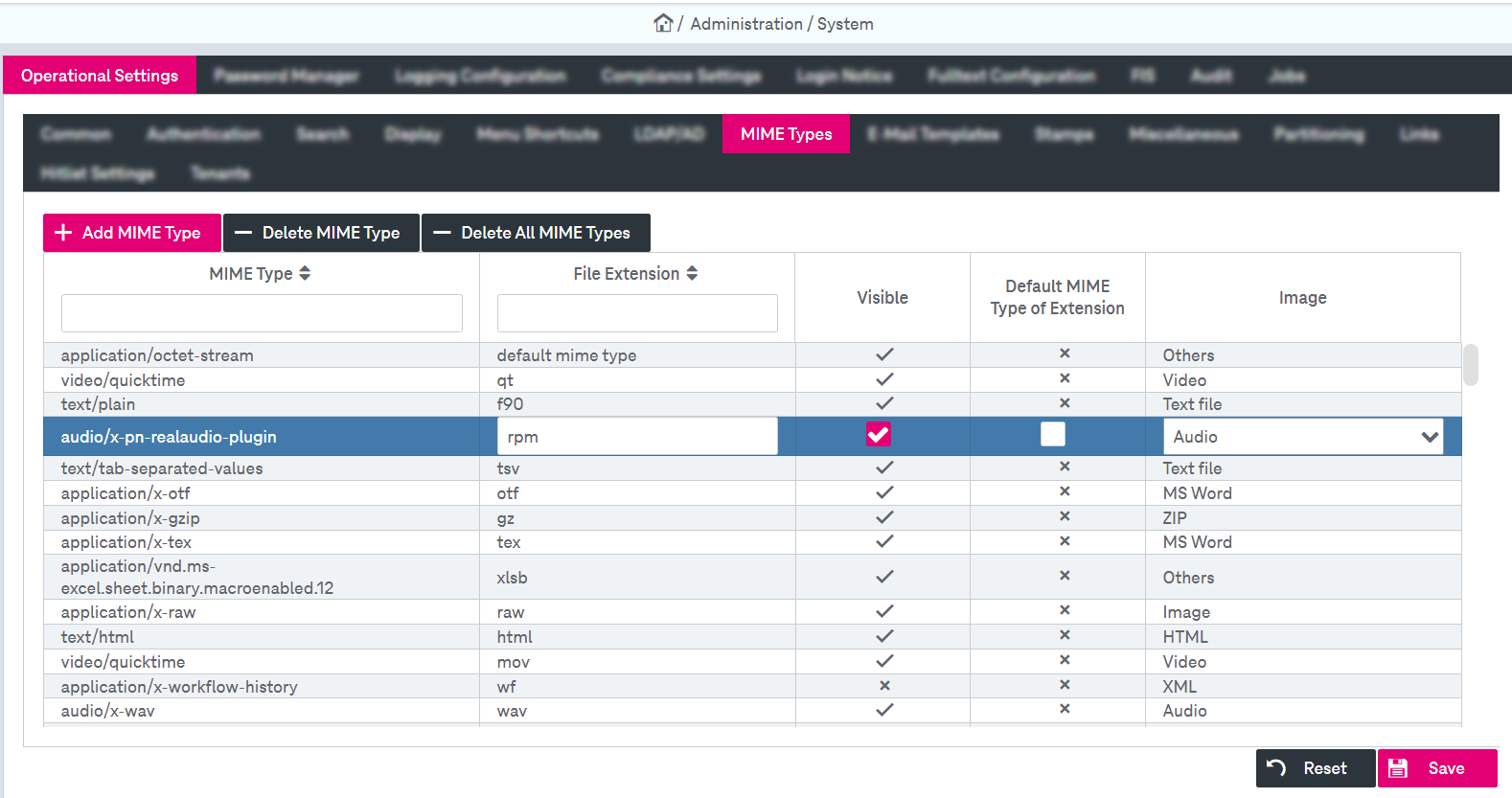The MIME type configuration provides a classification of document components based on file extensions of the binary content. This can be helpful for deciding about the behavior of viewers (which present file content based on a file extension) and about the handling of full-text extraction.
Click the Operational Settings > MIME Types tab to configure available MIME types with associated file extensions. The screenshot contains a mapping table of all MIME types with their assigned file extensions.
General information on MIME types
File extensions and MIME types are not unique:
-
The same file extension can be used with different MIME types.
-
One MIME type can have several entries with different file extensions as illustrated below.

Figure 33: System – operational settings: multiple file extensions for one MIME type
If the list is sorted by file extensions, the entries belonging to one MIME type can be located in different, non-consecutive positions in the list. Sort entries in the list by clicking on the column heading “MIME Type” to better see all file extensions that are associated with the same MIME type.
There are multiple concepts of a “default” in the context of MIME types:
-
Exactly one system-wide default MIME type is specified:
-
This default is identified by the file extension entry “default mime type”.
-
Typically the associated MIME type is “application/octet-stream”.
-
This MIME type is set for each document attachment uploaded by the WorkplaceClient if no other MIME type can be determined based on the file extension of the incoming file.

-
-
One “Default MIME Type of Extension” can be specified per file extension:
-
The same file extension can be used with different MIME type entries.
-
Exactly one of these entries (with the same file extension) can be marked as the default MIME type.
-
This default MIME type is set for each document attachment uploaded by the WorkplaceClient with the given file extension.

-
You can perform the following actions:
-
Change or add file extensions
The file extension allows the system to assign the associated MIME type to a file that is uploaded in the WorkplaceClient (as an ImageMaster document attachment).
-
Set the default MIME type of a file extension
If the same file extension is used for multiple MIME types, this default MIME type is set for a file with the given file extension, when it is uploaded in the WorkplaceClient (as an ImageMaster document attachment).
-
Define icon to be displayed
You can define which icon is displayed in the user interface for attachments of the respective MIME type. Such icons are shown in the document view and in the document preview.
-
Make MIME Type visible / hidden
You can define if attachments of certain MIME types are hidden from the display whenever the document is shown in the user interface. The visibility then depends on the permission “Show Hidden Attachments” (in Roles > Document Types). Also see Document type administration permissions.
-
Add / delete MIME types
You can add a new instance of the same type to add another extension to be assigned.
To change the file extension
-
Click the corresponding row of the MIME type.
-
Click the file extension cell. The cell becomes editable (see figure System – operational settings: MIME types).
-
Change the extension as you like. The input field must not be empty.
-
Click Save.
To define the default MIME type for a file extension
-
Click the corresponding row of the MIME type.
-
Click the file extension cell.
- Select the box Default MIME Type of Extension. The MIME type will be set as default with the corresponding label.
To make a MIME type visible or hidden
-
Select the box “Visible” to show or hide attachments of the corresponding MIME type.
-
Click Save.
To define an icon symbol to be displayed
-
Click the dropdown field Image for the respective MIME Type.
-
Select the image to be displayed.
-
Click Save.
To manage MIME types
-
Click Add MIME Type to specify a new MIME type. Enter a name and click OK. The new type appears in the bottom of the list.

-
Click Delete MIME Type to remove the selected item or Delete All MIME Types to remove all existing MIME types and confirm the deletion in the dialog.
-
Click Save.
